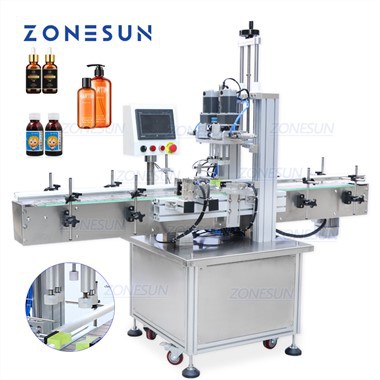Capping Machine
ONE-STOP CAPPING SOLUTIONS
Product Versatility
ZONESUN capping machines can be used for different types of bottle caps like spray caps, dropper caps, wooden corks, twist off caps.
After-Sales Support
Upon purchasing our equipment, you will have access to a full range of live training demos with our experienced technicians.

Customized Solutions
ZONESUN can customize capping machines to meet customers’ unique requirements. Make sure machine can work well with your products.
On-time Delivery
We have enough production capacity to meet order needs, and the shipment will be arranged as soon as the production is completed.
What is Capping Machine?
Capping machines are essential to a range of different industries where a proper seal is needed, and are used to attach or fix lids, caps or closures onto bottles or containers. With a wide range of both cap types and machines available, capping machines can be designed for a range of purposes and industries such as general packing operations, industrial purposes, food and beverage processing, agricultural, chemical or cosmetic applications.
The types of products that capping machines can be used for is hugely varied – from pharmaceutical supplies and medicines to household products, paint and beauty products. Essentially, if you have a product that needs a proper seal, a capping machine can help.
How To maintain Capping Machines?
1. Regular Lubrication
Lubrication is an essential aspect of maintaining a capping machine. The continuous movement of parts within the machine increases the risk of friction, which can damage the machine. To prevent such damages, apply lubricants to all moving parts of the machines. This will reduce the possibility of machine break down and prolong its life.
2. Cleaning
Keeping your capping machine clean is critical to its maintaining a smooth and consistent performance. Cleaning will remove dust, debris, and other impurities that can lead to malfunctions. While cleaning the machine, ensure that you pay particular attention to the vital parts such as sensors, actuators, pistons, and other moving parts. It's essential to clean the machine regularly, preferably after every use, to avoid any contaminants from affecting the integrity of the capping machine.
3. Inspect Machine Parts
Another way to maintain your capping machine is by inspecting and maintaining the machine component parts. Perform regular checkups on the machines' components such as belts, pulleys, motors, and switches, among others. This will identify any possible issues and enable the replacement of damaged parts before they cause significant damage to the machine.
4. Tightening Loose Screws or Bolts
Periodically check the machine components' tightness, such as screws and bolts, to ensure that they are appropriately tightened. Regular use of the machine can loosen the bolts and screws, creating a potential risk of malfunctioning. By regularly tightening the loose parts, you reduce the risk of breakdown and lower the maintenance costs.
5. Electrical Maintenance
Most of the capping machines operate through electric motors. As such, electrical maintenance is essential to prevent short circuits or even electrical fires. Ensure that all the electric components, such as switches, fuses, and circuit breakers, work correctly and that the wires are connected as required. Regular inspection and replacement of damaged wires and other electrical components will maintain the machines' longevity.
6. Train Operators for Safe Machine Operations
Finally, training the capping machine operators on the proper use and maintenance of the machine is critical. Having competent and well-trained staff will enhance the machine's safety, performance, and lifespan. Operators should understand the machine's manual, as well as how to troubleshoot problems with the machine promptly. Adequately trained personnel will identify potential issues early, making it easier to resolve before they become major issues.
Our Service Process
Pre-sales Consultancy
1
>>
Confirmation of order
2
>>
Production
3
>>
Arrange shipment
4
>>
Confirmation of receipt
5
>>
After-sale Services
6

FAQ
Which capping machine is suitable for my closures?
Consumers will find that there are different types of capping machines while browsing our website. The options will quickly be limited however, as different capping machines are manufactured for different closures. Spindle cappers and chuck capping machines are built to tighten screw-on, or continuous thread type closures. Corking machines are made for corks, T-corks and other cork-like closures. Once a consumer knows which type of closure they will use for their project, they can identify which capping machines will work with those closures.
Can capping machine handle all of my bottles and caps?
As noted above, capping machines are built for specific closures. As long as the caps are all the same type of closure - screw-on, snap, ROPP, cork - the capping machine will work for a range of cap sizes. As to bottles, capping machines are manufactured with simple adjustments that allow a range of bottle widths and heights to be run on the equipment. Some customized capping machines may even run multiple closure types, such as the spindle-snap capping machines that allows a packager to run both screw-on type closures and snap caps on the same machine.
How much space will the capping machine require?
Capping machines run from simple tabletop equipment to fully automatic inline machines. Tabletop cappers, as the name suggests, take up very little space and can be placed on a tabletop to complete the capping process. Automatic capping machines will include a conveyor and a cap delivery system, which will require more production space. The space available for the machinery will always be a consideration when assisting packagers in finding the best capping solution.
What's the payment terms and trade terms for new customers?
Payment terms:T/T,L/C,D/P,O/A, Western Union etc.





















